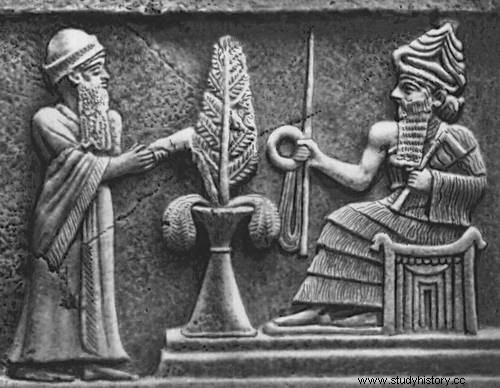History is unfair to women. And Ancient History, even more so. Official historiography says that, after the fall of the Akkadian Empire, the Guti people (it is believed that they are ancestors of the Kurds) came down from the mountains and devastated Sumeria creating small Taifa kingdoms in each city under the command of mountain kinglets. For 120 years there was an age of cultural darkness. Hardly any documents or statues have been preserved. It is a true dark age. However, after that time, the rebellion began in the city of Ur that led to the fall of the Guti kings and the beginning of the neo-Sumerian era. This rebellion was carried out by Utukhegal , who proclaimed himself king of Ur after removing the mountain ruler of the day. But he made a serious mistake:if you want to mount an insurrection, you must have the army on your side. The troops were commanded by General Ur-Nammu, which, as usual, organized a coup and snatched the crown. And it is with Ur-Nammu with whom the Third Dynasty of Ur begins , known as “Sumerian Renaissance ” and also as “Golden Age of Women ”. King Ur-Nammu fills entire pages of history books, because apart from being a great general who ate dates - the tomato had not yet been brought from America - all the gutis kings and amorrite nomadic tribes that were put before him, he bequeathed us one of the oldest law codes, previous to that of Hammurabbi, and a nice collection of Bacchic poems that unfortunately have been lost (as my grandmother would say:“drunken songs ”, and it is that the monarch was very fond of raising his elbow).

Ur-Nammu
In most of the books he is credited with building the first ziggurats in history, most of which he could not see completed, although it only took four or five years to build one. However, we must be realistic. Although it is true that the idea of creating a building like the ziggurat must have occurred to him, since the conquerors' obsession with size is well known, he must not have had time to run the show, because at the end of his reign he was very busy exchanging opinions (warlike, of course) with the Amorrite nomads. Between battle and battle, the little time he had left he must have dedicated to the charms of his concubines and beer tasting, which are not bad pastimes.

Ziggurat UR
In the books it is said that he made her daughter Ennirgalanna high priestess of the Holy Precinct of Ur. . It is often understood that this happened after the construction of the ziggurat of Ur, the first in history . And here begins one of historiography's typical dismissals of women. And we have proof that Ennirgalanna was already Entu (high priestess) before the construction of the ziggurat. Remains of the grave goods of the Entum have been found in the excavations of Ur prior to the III Dynasty of Ur, which must have been fleeced by the Gutis when they invaded the city. In some of the pieces there are texts that indicate that Ennirgalanna ordered the restoration and collection of the shattered pieces, the remains of the library and that she fixed the priestly residence of the temple. Only after this reorganization, with the campus operating at full capacity, with the factories rebuilt, the priestly residences and schools erected and the theological system imposed, could such an innovative work be undertaken.
Sumerian princesses and queens used to run their own business offices, making their husbands rich while they focused on the charms of their concubines. Sumerian cultured women were educated and Ennirgalannana Also, she was the Entu of the sanctuary. She was the goddess Ningal reincarnated on earth. She directed the scribes, signed the contracts, controlled the accountants, dispensed justice in the sacred precinct... And, obviously, she had to direct the works, hiring the workers and architects. Further evidence is found in the fact that, although the ziggurat was dedicated to the lunar god Nannar (Without in Akkadian), the upper temple was dedicated to the goddess Ishtar , of which we know that Ennirgalanna was very devoted, as a worthy successor of the great Enheduanna .
Fortunately, times change, and current historians are willing to highlight the figures of those women who were unfairly forgotten by history . From now on, when you see a picture of the Ziggurat of Ur, think of THE WOMAN.
Contributed by Joshua BedwyR
